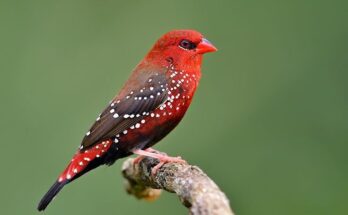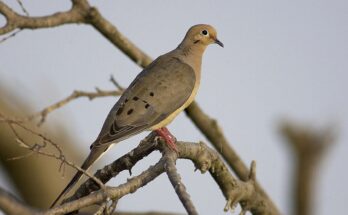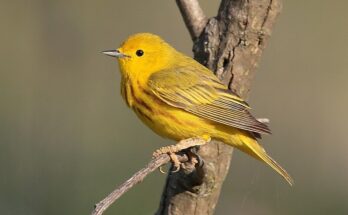Did you know Michigan is home to many blue birds? These birds are a hit with nature lovers and birdwatchers. From the bright Indigo Bunting to the loved Eastern Bluebird, they add colour and songs to Michigan’s landscapes.
In this guide, we’ll look at 11 types of blue birds in Michigan. We’ll share details on their looks, where they live, how they act, and how to tell them apart. This will help you find these amazing birds on your outdoor trips.
Michigan’s blue birds are a real treasure. They show the state’s rich bird variety. When you’re outside, look for these amazing birds. Enjoy the beauty of Michigan’s blue bird world.
Here I’ll Explore 11 Different Types of Blue Birds Found in Michigan!!
Michigan is a haven for blue bird species, each with its own charm. We’ll look into 11 types of blue birds in the state. You’ll learn about their looks, where they live, and how to spot them. This will help you appreciate Michigan’s blue bird beauty.
The different types of blue birds found in Michigan include:
- Indigo Bunting
- Eastern Bluebird
- Blue Jay
- Black-Throated Blue Warbler
- Blue-Gray Gnatcatcher
- Cerulean Warbler
- Tree Swallow
- Purple Martin
- Belted Kingfisher
- Great Blue Heron
- Barn Swallow
These blue birds live in many places in Michigan, from gardens to forests and wetlands. Their bright colors and interesting ways make them fun to watch. In the next parts, we’ll dive into what makes each of these 11 blue bird species special in Michigan.
Indigo Bunting
The indigo bunting is a small bird found in Michigan. The male has bright blue feathers, making him a standout. Females are brownish, less noticeable.
Appearance
These birds are about the size of a sparrow. Breeding males are a deep blue, especially on their heads. Females and young males are brown with faint streaks and sometimes blue on their wings or tail.
Habitat
Indigo buntings are like open spaces with trees, like fields and gardens. They migrate, spending summers in Michigan and winters elsewhere. You might see them singing from trees or lines during breeding season.
Behaviour
They build nests from grasses and leaves. They eat seeds in fields and migrate at night, using the stars.
Identification
Spotting an indigo bunting is easy thanks to its blue feathers and small size. Nonbreeding males can be tricky to spot. To attract them, try a feeder with thistle or nyjer seed.
Check Our Previous Posts: 6 Types of Hawks of Georgia
Eastern Bluebird – Michigan’s Beloved Blue Bird
The eastern bluebird is a favorite among bird lovers in Michigan. It’s known for its bright colors and sweet song. These birds have bright blue feathers, a rust-colored chest, and a white belly. Males are a stunning blue, while females are more subdued.
Eastern Bluebird Identification Tips
To spot eastern bluebirds in Michigan, look for their short tail and stout bill. Listen for their cheerful songs. They like open spaces like grasslands and orchards for nesting.
Eastern bluebirds mainly eat insects and fruits. They play a key role in Michigan’s ecosystem. Their beauty and love for Michigan’s habitats make them a cherished symbol.
Blue Jay – A Bold Blue Bird in Michigan
The Blue Jay is a striking bird found all over Michigan. It has bright blue feathers and a unique crest on its head. This bird is medium-sized, about 9-12 inches long, and has a wingspan of 13-17 inches.
Distinctive Features
The Blue Jay stands out with its bright blue color and black and white markings. It also has a strong, sturdy beak for cracking nuts and seeds. Both males and females have the same bold, blue color.
Habitat Preferences
Blue Jays can live in many places, like forests, woodlands, and even suburbs. They often hang out near oak trees in forests and woodlots. Their loud calls can be heard across Michigan.
Blue jays are a joy to watch in the Michigan outdoors. They are a favorite among birdwatchers and anyone who loves blue birds. Their bold colors and behavior make them a standout in Michigan wildlife.
Learn More About Birdfy Nest – Smart Bird House with Dual Cameras
For birdwatchers and nature lovers in Michigan, the Birdfy Nest is a great tool. It lets you see the nesting and breeding of various birds, like the Eastern Bluebird and Indigo Bunting. This smart bird house has two cameras.
It’s a chance to learn more about blue birds and their lives. You can do this from home. The Birdfy Nest is perfect for those who love Michigan’s birds.
| Birdfy Nest Features | Specifications |
|---|---|
| Video Camera Resolution | 1080P FHD |
| Waterproof Rating | IP66 |
| Package Weight | 12lb/5.5kg |
| Warranty | 2-year |
| Network Connection | 2.4GHz WIFI |
| Predator Guards | Included |
| Battery Capacity | 8800 mAh |
| Dimensions | 6.9″L x 7.6″W x 15.7″H |
| Material | Bamboo |
| Bird Behavior Recognition | Lifetime Free |
The Birdfy Nest has cool features like dual cameras and a weatherproof design. It also has a long battery life. It’s a great choice for birdwatchers in Michigan. You can watch blue birds in their natural setting.
Barn Swallow
The barn swallow soars through Michigan’s skies with grace. This blue bird is known for its long, forked tail and slender body. It’s common in open fields, meadows, and near water.
Did You Know?
The barn swallow is found worldwide, with many subspecies. These birds are expert insect hunters. They fly acrobatically, catching prey in mid-air.
Key Characteristics of the Barn Swallow
- Steely blue backs, wings, and tails, with rufous to tawny underparts
- Differences in appearance between males and females, with males having longer outer tail feathers
- Nests typically located under eaves or inside structures, made of mud and dry grasses
- Forages in flocks, often flying low to the ground in a light and agile manner
- Slightly smaller than a bluebird and slightly larger than a tree swallow
The barn swallow thrives in many habitats. It was once found in caves but now nests on human structures. This includes barns, sheds, and bridges.
These birds are a favorite among nature lovers and photographers. As you explore Michigan, look for these blue birds. Marvel at their journey from Michigan to Central and South America and back.
Black-Throated Blue Warbler
The black-throated blue warbler is a stunning migratory songbird found in Michigan’s forests and woodlands. It has a blue back, black throat, and white belly. This makes it a favorite among birdwatchers and nature lovers.
The black-throated blue warbler stands out with its deep blue upper parts and white belly. Males have jet-black faces and throats, creating a bold look. Females have a grayish-olive back and a white wing patch.
These blue warblers in michigan migrate to the Caribbean and Central America for winter. In summer, they sing in Michigan’s forests. Their songs are described as “I’m so lazy.”
Black-throated blue warblers live in mature forests with a dense understory. They forage for insects and spiders in the lower canopy. Their sharp bills help them pick prey from leaves.
The black-throated blue warbler is a highlight of Michigan’s bird diversity. It captivates with its striking looks and songs. Whether you’re a seasoned birder or just starting, look out for this beautiful bird in Michigan.
Blue-Gray Gnatcatcher
The blue-gray gnatcatcher is a small but charming bird found in Michigan. It has blue-gray feathers, a long tail, and striking black and white markings on its face. These features make it easy to spot.
These birds are often seen flying in wooded areas and forests across the state. They hunt for spiders, flies, and other small bugs. Their quick and agile flight is a joy to watch, accompanied by their high-pitched calls.
Birdwatchers in Michigan have a good chance of seeing these birds. They can be found in many natural habitats, from east to west. This makes it easier to see their beautiful presence.
Though not as famous as some other blue birds in Michigan, the blue-gray gnatcatcher is a hidden treasure. It’s perfect for bird lovers and nature fans. Keep an eye out for it while exploring forests or parks. It’s sure to amaze and inspire you.
Cerulean Warbler
The cerulean warbler is a stunning blue bird found in Michigan’s forests and woodlands. It has a bright blue back, white belly, and a black necklace-like pattern on its chest. Sadly, its numbers have dropped a lot, prompting efforts to save its home and nesting sites.
Birdwatchers in Michigan are key in helping the cerulean warbler. They track and support the bird’s numbers. They’ve found cerulean warblers in many counties, including Livingston, Alcona, and Oakland. The latest sightings were in 2022 in Berrien, St. Joseph, and Cass counties.
Conservation Efforts for the Cerulean Warbler
The cerulean warbler’s numbers have fallen by over 74% since 1966. To help, conservation plans are in place. These include:
- Keeping large areas of mature deciduous forests intact
- Protecting old-growth floodplain habitats
- Using Best Management Practices in forestry
- Removing Brown-headed Cowbird eggs from cerulean warbler nests
These steps, along with the birding community’s hard work, aim to keep the cerulean warbler in Michigan. By protecting its habitat and addressing threats, we can ensure its beauty for future generations.
Tree Swallow
The Tree Swallow is a beautiful blue bird found in Michigan. It has a shiny blue back, white belly, and a long, thin body. These blue swallow michigan love open places like fields and wetlands to find food.
Tree Swallows are amazing flyers, catching insects in mid-air. They also nest in tree holes or boxes. Their arrival in Michigan means spring is coming.
Research shows that adult males are blue-green above and white below with blackish flight feathers. Adult females can be nearly as blue-green as males. They are smaller than Purple Martins but bigger than Bank Swallows. Adult males have a thin black eye mask, while females are duller with more brown in their upper parts.
After breeding, Tree Swallows form large flocks for molting and migration. They also gather in huge communal roosts in the nonbreeding season. Tree Swallows breed in open habitats such as fields and wetlands, usually adjacent to water. Foraging flocks of Tree Swallows are commonly seen over wetlands, water, and agricultural fields.
Interestingly, Tree Swallows are the most common competitors for bluebird nesting boxes. They are usually more aggressive than bluebirds and often take over bluebird boxes, especially in areas with abundant water sources. House Wrens, despite their tiny size, are known to be competitive nest box occupants, and Black-Capped Chickadees are generally at the bottom of the pecking order when competing for nest boxes.
| Species | Nest Box Competition |
|---|---|
| Tree Swallow | Most common competitor for bluebird nesting boxes, often more aggressive than bluebirds |
| House Wren | Competitive nest box occupant, despite their small size |
| Black-Capped Chickadee | Generally at the bottom of the pecking order when competing for nest boxes |
Purple Martin
The purple martin is a striking blue bird found in Michigan. These large swallows have deep, iridescent blue feathers. They live in big groups and nest in artificial homes like gourds and houses.
These birds are great at catching flying insects like mosquitoes and dragonflies. Seeing them in Michigan is a treat. Their calls and flight add beauty to the state’s landscapes.
Since 1966, Michigan’s purple martin numbers have dropped a lot. In the Upper Peninsula, their numbers fell by 95% before starting to rise again. Climate change and fewer insects are big reasons for this decline.
The Purple Martin Conservation Association is working hard to save these birds. They have projects like Project MartinWatch and a Scout-Arrival Study. These help track the birds and guide conservation.
Backyard birding is becoming more popular, and purple martin boxes are a big part of it. By helping these birds, we can keep them in Michigan’s nature. This is a great way to protect these amazing birds.
Belted Kingfisher
In Michigan’s bird world, the belted kingfisher is a standout. These blue birds are found across Canada and most of the United States, including Michigan. They have a unique crest, sturdy body, and long, sharp beak. They often sit on branches or power lines near water.
The belted kingfisher is a skilled hunter. It uses its sharp eyes and fast dives to catch fish. It also hunts frogs, small crabs, and crayfish. In the air, it’s easy to spot because of the large white patch on its wings.
Females are more colorful than males. They have a chestnut belly band and flanks. Young birds have rusty spots on their breast bands. They are smaller than an American Crow but bigger than a Hairy Woodpecker, similar to a robin.
Their loud, rattling call is common in Michigan’s waterways. These blue birds are crucial for the balance of aquatic life. Their presence shows the beauty of Michigan’s nature.
| Characteristic | Description |
|---|---|
| Appearance | Stocky build, large head, shaggy crest, dagger-like bill, blue-gray upperparts, white underparts, chestnut belly band and flanks (females), irregular rusty spotting in breast band (juveniles) |
| Size | Smaller than an American Crow but larger than a Hairy Woodpecker, similar in size to a robin |
| Habitat | Near rivers, lakes, and ponds, often perching on branches or power lines |
| Behavior | Skilled hunter, plunging headfirst into shallow water bodies to catch fish, amphibians, reptiles, and other aquatic prey |
| Nesting | Burrows excavated into shoreline banks, ditches, road cuts, landfills, and sand/gravel pits |
| Diet | Primarily fish, with occasional crustaceans, reptiles, and aquatic insects |
Great Blue Heron
The great blue heron is a common sight in Michigan. It can be found near lakes, rivers, and wetlands. These blue birds stand out with their large size, long legs, and blue-gray feathers.
Great blue herons are skilled hunters. They use their sharp beaks to catch fish, amphibians, and small mammals. They wade in shallow waters, waiting to strike unsuspecting prey. Their flight is graceful, with broad wings and slow beats.
In Michigan, great blue herons live in various wetlands. They build their nests in wooded swamps or on islands with mature hardwood trees. Their nests can be up to 98 feet high.
The number of Great Lakes coastal heronries in Michigan has grown by 62% since 1987. This shows a healthy great blue heron population. But, we must protect their nesting sites from human disturbances. A 300-meter buffer zone is recommended during breeding season.
The great blue heron is a majestic bird in Michigan. It plays a key role as a top predator. It also offers great opportunities for outdoor enthusiasts to see these amazing blue birds.
Blue Birds in Michigan
Michigan is home to many blue birds, each with its look and habits. You’ll find the Indigo Bunting, the Eastern Bluebird, and the Great Blue Heron. These blue birds bring colour and life to the state’s landscapes. They also play a big role in Michigan’s nature.
Helping these blue birds survive is important. This includes making homes for them and protecting their habitats. Spotting a Blue Jay or a Cerulean Warbler shows Michigan’s beauty and variety.
Blue birds live in many places in Michigan, like prairies and forests. Species like the Barn Swallow and the Belted Kingfisher add to Michigan’s bird life. They make birdwatching and exploring nature even more special.



